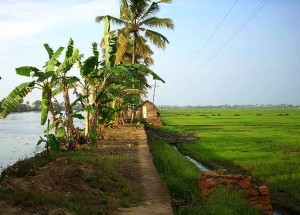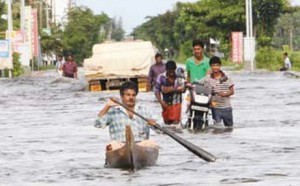
The Five were here
Any place with a captivating degree of scenic lure, the Pandavas have been there before you. Seasoned domestic explorers will agree that the famous five have traipsed over every picturesque mountain and verdant vale, camped across the most spectacular lake and gushing river and traversed every panoramic forest. At least according to local lore. The locals of Kuttanad too believe the warrior brothers passed through the region; even cite passages from the Mahabharata to corroborate their claim. Of course then it was not the ‘rice bowl’ it is today, neither was it the Vembanad Lake it was earlier. It was a lush forest, teeming with wildlife where many myths came alive and history played out. That is till it was destroyed by a major forest fire and became ‘Chuttanad’ or ‘burnt place.’ If you dig deep today, you still get coal. Ramankary, Kainakary, Changankary…goes some of the villages here. ‘Kari’ is coal in Malayalam.

State's rice bowl
Under the Chera dynasty who ruled over ancient Kerala, Buddhism flourished here earning it the sobriquet ‘Buddha-nad’ (land of Buddhism) which eventually became Kuttanad. Kuttanad is a large tract stretching for at least 75 km from Kollam in the south to Kochi in the north, sandwiched between the sea and the hills. It is carved out – mired out, rather – from three districts of Kerala – Kottayam, Pathanamthitta and Alappuzha. Kuttanad is known as the ‘rice bowl of Kerala’ as it is largely paddy fields and supplies the bulk of the state’s staple diet. An interesting fact about Kuttanad is that this is among the very few regions in the world where farming is below sea level – some four to 10 feet lower in some areas. Mere interest leads to astonishment when you consider that this is land reclaimed – over hundreds of years.

This is reclaimed land
The earliest recorded period of reclamation began in 1865 when ‘chakram’ or water wheels were used to bail out water from the shallower parts of the Vembanad Lake. The farmers, traditionally an impoverished lot, had to borrow money from the upper caste Brahmins for their agricultural needs. This was repaid with paddy. Limited access to resources and primitive technologies saw to it that only about 250 hectares of the lake was reclaimed during 1865 to 1890. Large tracts of the Vembanad Lake earmarked for reclamation were given names and Venad Kayal (‘kayal’ means ‘lake’) Madathil Kayal were the first ‘kayal nilam’ or ‘lake areas’ which were added to the Kuttanad of today. From 1898 onwards things got easier with the introduction of dewatering engines which ran on kerosene. Reclamation, earlier limited to scattered, shallow areas around the Vembanad, ventured farther, deeper. Perhaps all the water, the enterprising farmers who later came to be called ‘kayal rajas’ (‘lake kings’) attracted the attention of authorities who banned all activities in the lake in 1903. Though the ban went on for 10 years, finally when it was lifted water was pumped out with more fervour than ever before. A sharp fall in rice prices during the 20s saw a lull in reclamation activities. Finally during the 40s, the government announced its ambitious ‘Grow More Food’ programme and with it more incentives to reclaim paddy fields from the lake. By now electric motors were available which saw the rise of many more new kayal rajas. As the land for cultivation increased, so did the demand from it – instead of the two cultivation cycles per year, the rajas and their subjects wanted a third one.

Bunds - Good or bad?
Now for paddy to come up you need non-saline water – a tall call considering bordering the other side of the Vembanad, it’s the Arabian Sea. So during summer, seawater enters Kuttanad due to its low levels making the third cycle rather impossible. A myopic government in 1968, of course pressured by demands from the local community, decreed the construction of bunds to prevent the inflow of seawater during summer. What they didn’t know – or probably they did, nobody knows – was that a certain amount of salinity was required for the fishes to breed. When the bund came up, the number of fish and their varieties came down drastically. The mild salinity was also handy in weeding the waters of the African moss that carpets the area. The proliferation of the moss increases the demand of fertiliser used in the fields – which adds to its own growth. As recent as 2005, the farmers woke up to the follies of their past and began opposing the bunds. But the need of the hour is more than mere dissention, even discussion. Doubtlessly, unconscionable reclamation has taken its toll – today what we have of the Vembanad Lake is less than one-third of what it was a century ago. What we should have known is that nature doesn’t take kindly to anybody messing with it.

Payback time
In what has been the worst devastation to hit Kuttanad in recent times, the floods this year damaged over 2,000 houses and at least 60 per cent of agriculture. Not just paddy fields or volleyball grounds are submerged in water but the rooms inside too. Among the dead are Kunjumon, aged 45 years, from Kainakary village who fell off his cot into the waterlogged floor of his house. An entire kindergarten has been washed away. Over 200 relief camps are functioning in Kuttanad, spilling over with survivors with barely enough to keep themselves alive. Sure enough the government has dispatched its emissaries to assess the situation and promise all help. The district collectors have been told to submit reports on how to face flood calamities in future. The authorities almost seem reconciled to the fact that we have to bear the brunt of a violated nature; the report asked for was not on how to prevent calamities.

Adding to woes
Houseboat tourism along the waterways here could also be at the receiving end of this calamity. It’s been some 25 years since it dawned on the mind of the enterprising Kuttanadan that the rice barges – made defunct as roads proliferated – could be converted into ‘kettu vallams’ or houseboats to ply tourists who wanted to see the bucolic life up and close. Originally intended to transport rice from the paddy fields, these behemoths are made of well-oiled jack wood, thatched roofs of palm and roped coir and some even come equipped with air conditioned rooms and Jacuzzi. Almost every decent hotel or heritage homestay that line the Vembanad own one; one count pegged their total number at 600. Though a bit on the expensive side, their demand has skyrocketed the past years and is slated to go up as
seaplane service took off in Kerala recently. But the unprecedented flood and destruction may not throw up the kind of sights one would want to take home.
Land reclamation is like implanting silicone, the gratification is immediate. What you have in the long run is certain discomfiture and a gnawing pain. Building bunds come with its own set of problems as does demolishing them. Environmentalists say that river spillways and poorly planned constructions that encroached into areas meant for the water bodies have worsened the situation. A representative of the state disaster management office pointed out that with all the construction in the region, ‘there is no space left for the lake.’
Guess what he meant was there was no space for the lake. For the lake is now back the way it was.


















A well written piece on a subject one had decided to forget. The seemingly pristine environment of Kuttanad is bleeding right under our noses and we the public and the government are ignoring the facts. Thanks for bringing the matter to notice.
Yes Austin.. those poor souls are bleeding. Its indeed a sorry sight, those refugee camps, shared rations and huddling together, infant wails… Then, wasn’t it all coming…